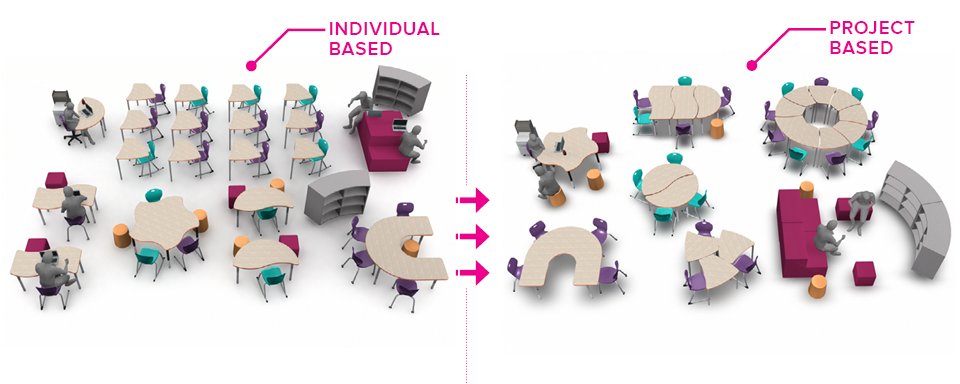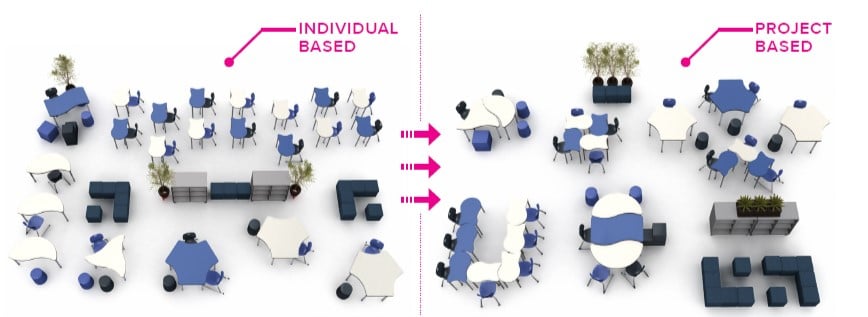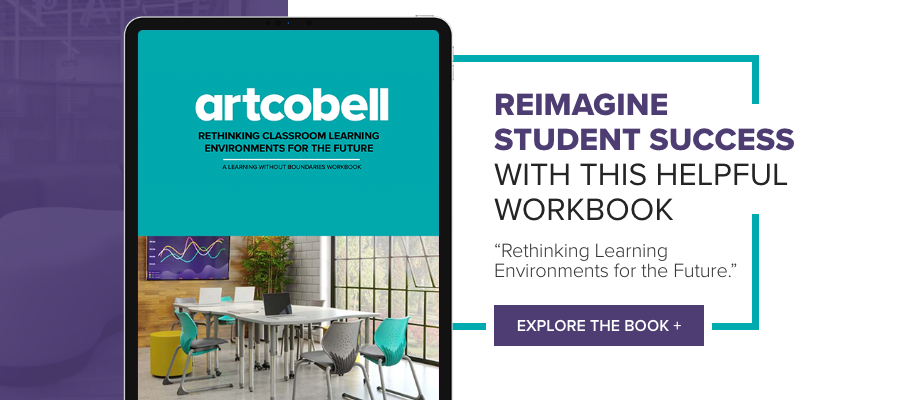School administrators and teachers across the country recognize the need to adapt their classrooms using new styles of learning. Only recently, however, are they seeing the significance of employing flexible classroom furniture to make it all work.
This is part of Artcobell's "Flexible Furniture" series.
- How Flexible Classroom Furniture Reinvents Learning
- Flexible Seating in Schools & Why It's Crucial for Classroom Setup
- The Living Classroom: Elements of a Flexible Learning Environment
- Connecting the Dots in the Classroom with Flexible Furniture
The Shift Towards Flexible Learning Environments
The move toward active and collaborative learning brings a much-needed change into the traditional learning environment – that is, the flexibility to curate lessons and classroom layouts to match the learning needs of students.
However, many schools are not sure of how to convert from a traditional, lecture-based classroom into a more collaborative and flexible setup. Professionals are looking to discover how they can align their classroom furnishings with their teaching styles and their students’ learning styles.
If you’re like most teachers and administrators, you’re asking questions like, “What is the right layout for my school? What features should I look for when selecting new, flexible classroom furniture? Can the conversion happen in phases? Where is the best place to start?”
Take a look at how some schools are reinventing the tried-and-true lecture-based classroom set up for today’s classroom that supports individual, collaborative and project-based learning.

Related Article: How to Establish an Active Learning Classroom
A Flexible Approach to Individual-Based Learning
While research supports project-based and collaborative learning, flipped and blended classrooms, and active learning strategies as proven ways to increase student engagement and achievement, there is still a need for individual-based or traditional instruction. Students need an environment in which they can focus, work, and demonstrate their knowledge of content.
Traditionally, lecture-based learning is a presentation method where the focus is on the material and the delivery is by the instructor. In a nutshell, teachers teach the lesson and students listen.
Today, instructors are expanding the lecture-based model to include activities that are essential for students to grow cognitively. Activities like reflection journals, goal setting, focused writing, assessments, independent work, and organization are important activities for students to acquire important skills to support their social-emotional and academic growth.
Benefits of Individual-Based Learning
There will always be a place in the classroom for individual-based learning. Here are the top reasons why:
- It helps learners process information, encourages them to be mindful of their actions, and allows them the time to demonstrate their learning.
- It offers a quick & straightforward way to provide information to students.
- It gives students a designated time on task to complete assignments and meet deadlines.
- It helps focus students toward listening, communicating, and providing feedback.
Promote Collaborative Learning with Flexible Classroom Furniture
Re-defining the Rules of the Classroom
Traditional classroom layouts are very linear and inflexible by nature. The teacher sits at the front of the classroom while the students are lined up individually in rows. This configuration is not conducive to a collaborative environment.
So, how are things changing? Students are learning differently and teachers are adapting the way they present material. By employing flexible classroom furniture, teachers have more options to build a learning environment that adapts to their students’ different styles of learning. Collaborative, mobile, and flexible classroom furniture comes in shapes and sizes that support teacher's engagement with students.
For example, a teacher might need to start the day with an individual-based set up in the morning but will need to switch to a collaborative layout for the afternoon as the students work through practical exercises.

Classroom Setup Tips to Encourage Different Types of Learning Styles
Here are some examples of how teachers have successfully incorporated non-traditional learning into the classroom to engage their students after individual-based learning sessions:
| Individual Technology-Infused | Collaborative and Project-Based |
| Use of animated video libraries, such as TedEd to spark ideas. | Allow students to work in teams to create their own “TedEd” video to teach concepts to other students in the class. Have students critique each other’s work. |
| Introduce global online classrooms, such as the Khan Academy, to allow students to grow their interest. | Group students based on common interests and assign a project designed around information from the Khan Academy lesson. |
| Incorporate interactive games, like Kahoot, to engage students. | After reviewing academic vocabulary with a Kahoot game, put students in groups to design models that would represent the words. |
We live, teach, and learn in a world that is continually redefining traditional spaces. A one-size-fits-all approach to classroom setup and furniture might have worked well 50 years ago, but today’s students and teachers have more resources available than ever before. Schools are discovering the value of collaborative, active learning setups made possible with flexible classroom furniture.
How to Get Started Using Flexible Classroom Furniture
If you’re ready to experience all of the benefits of a collaborative learning environment in your school, we can help! At Artcobell, we’re passionate about helping teachers & administrators find the right school furniture to promote student success. Check out the virtual classrooms to find more ideas that support your needs or talk with a dealer to get started.

